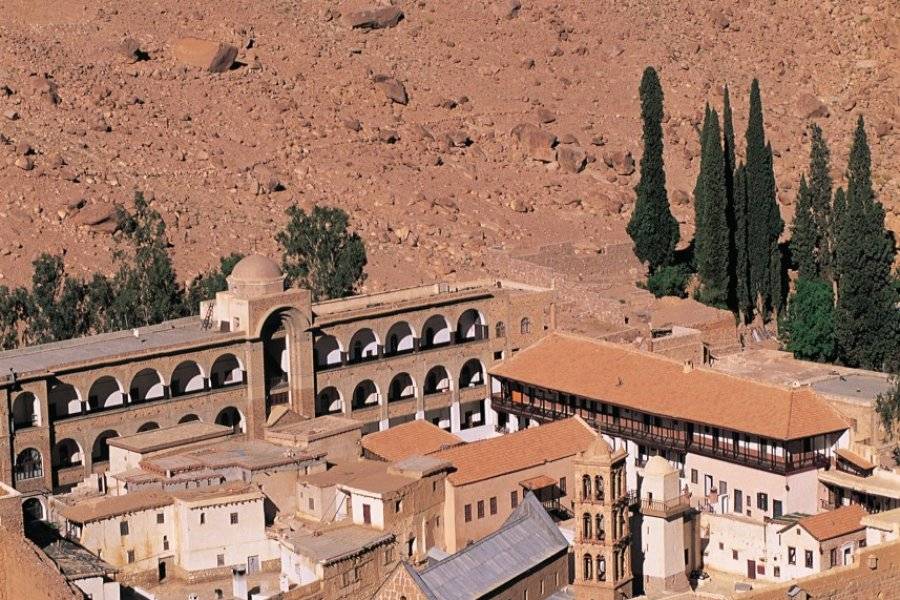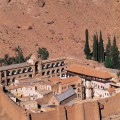MONASTERE
Go there and contact
St. Catherine's Monastery, also known as the Monastery of the Transfiguration, is a magnificent complex perched at 1,570 m above sea level. Listed as a UNESCO World Heritage Site, it is one of the oldest monasteries in the world still in use, and certainly one of the finest examples of Byzantine architecture. Almost all of its walls date back to its construction, ordered by Emperor Justinian (in 527). The monastery was intended to protect hermits from looters. The architect Ailisios, in charge of the work, chose a site where a chapel marked the location of the bush-ardent. To avoid destroying it, he incorporated it into the construction of a new church and protected the whole complex with a powerful wall 2.6 m thick, thus creating both a monastery and a fortress. It is said that Ailisios was condemned to death and executed for not placing the monastery on top of Mount Moses. His choice proved wise, however, as the monastery withstood looting, wear and tear and earthquakes. Two hundred families from Macedonia, Romania, Egypt and Arabia were dispatched to protect the monks and provide the stewardship. From the 8th and 9th centuries onwards, the descendants of these families converted en masse to Islam, and today form a very specific and localized tribe, the Jebelyeh (mountain people). Although Muslim, they recognize the spiritual authority of the Archbishop of Sainte-Catherine.
Throughout their existence, edicts (some signed by august hands, such as those of the Prophet Mohammed or General Bonaparte, to name but the most famous) have protected the monks, and only the Bedouins have had any difficulty in respecting them. The greatest threat came from Egypt in the 11th century, when the Caliph Hakim came to the valley with the intention of razing the monastery to the ground. This fanatical ruler had already destroyed numerous Christian buildings. This time, however, he gave up in extremis, in exchange for a mosque to be built on the monastery's grounds. During the Egyptian campaign, Bonaparte had some parts of the enclosure restored, including the north-facing wall. The opening of an entrance door eliminated the need for the wooden elevator that had previously been the only means of access inside the walls. The wooden gallows and pulley are still visible.
Around a third of the building is open to the public. You'll see the basilica, the oldest parts of which date back to the 6th century. In addition to its 12 massive granite columns representing the 12 apostles, it is rich in superb icons... The Transfiguration Mosaic is remarkable: created in memory of Justinian's wife, its 500,000 pieces date back to the 6th century. Pierre Loti described his moving visit thus: "The two leaves of a cedar door carved 1,300 years ago are opened before us, and we enter into the astonishment of this unique place in the world... The view, at first, is dazzled and disconcerted by the profusion of chandeliers, silver lamps... One feels plunged into a naïve and magnificent past, so distant and yet so present that it worries the mind..."
The burning bush is located outside the church, in front of the apse. In 2000, Pope John Paul II paid his first visit to Coptic Orthodox lands. The chapel of the bush-ardent, located behind the church choir, is considered the most sacred place in the entire monastery. The altar is erected on the roots of the bush, making it the most sacred place in the monastery. Like Moses, you must take off your shoes before entering.
What you won't be able to see: the treasure trove of gifts from devotees (gold chalices, candlesticks, bishop's crosses and crosses...); the mosque, refectory, icon collection... (there are said to be over 2,000); the library, considered the second largest in the world after the Vatican in terms of manuscripts and incunabula. It contains over 32,000 manuscripts, most of them written or copied by the monks of the monastery over the centuries (visit available on request). In order to preserve its archives, the Monastery has undertaken the digitization of all its documents. Don't be surprised if you don't hear the nine bells donated by the Russian Church: they only ring on feast days. Every day, a wooden bell punctuates the day.
The monastery's community is made up of around twenty monks, under the leadership of their abbot, whose particularity in the Orthodox world is that he is autocephalous (an independent head). Indeed, since an imperial decree gave them this privilege, the monastery's abbot is subject to no higher jurisdiction than his own. Belonging to the Greek Orthodox Church, whose patriarch has, in principle, no authority over the monastery's abbot.
An ossuary is located outside the enclosure. These are the remains of the monks who died in the monastery. So as not to waste the little arable land they had, the monks had only a very small cemetery. They were buried here and, a few decades later, their bones were deposited in this room. The ossuary was closed to visitors in 2020.
Did you know? This review was written by our professional authors.
Members' reviews on MONASTERE
The ratings and reviews below reflect the subjective opinions of members and not the opinion of The Little Witty.





